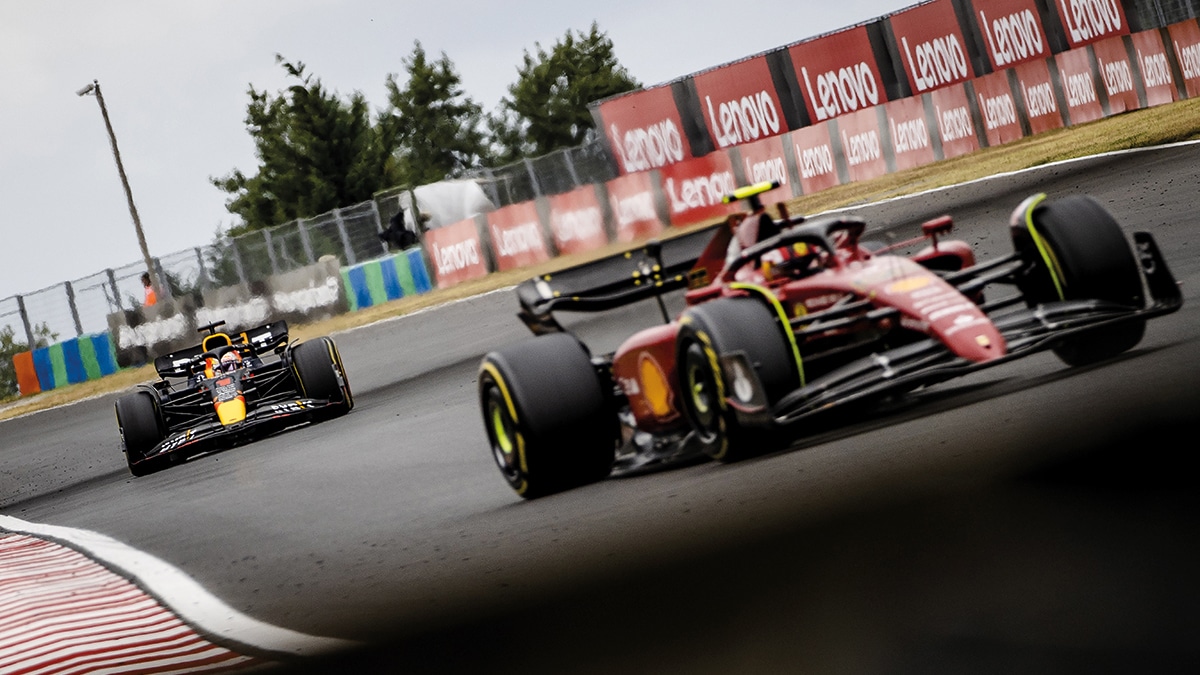Ferrari in the cooler
Race strategy is crucial – as long as you have the pace. The Ferraris were blistering when the Hungarian heat was on, but come a cool race day it all changed, as Mark Hughes</strong relates

With sensational pace on Friday Ferrari expected to dominate but a temperature drop struck home – and so did Max Verstappen
ANP via Getty Images
Red Bull made some great strategy calls in winning Verstappen the Hungarian Grand Prix from 10th on the grid. But underlying it all was Verstappen’s pace advantage. As rival Carlos Sainz observed, “If you don’t have the car pace, the strategy cannot really help you much.”
Ferrari, for the only time this season, did not have the car pace. That difference between Verstappen and an off-form Ferrari – which had been dynamite in the hot conditions of Friday, with the biggest advantage over the field seen all season, but which fell a long way out of its sweet spot when conditions became 20°C cooler on Saturday and Sunday – eased Red Bull’s strategic task considerably.
As Verstappen’s pace and Red Bull’s strategy calls combined to place Ferrari in a corner, it ran out of viable answers. Putting Leclerc onto the hards at his second stop was seen as a mistake post-race, but it was a decision forced upon them by Verstappen. The only alternative was to surrender to Verstappen immediately and keep running – as Leclerc wanted to do – to at least get onto the soft later on. Or to fit the hard. Because with 31 laps to go the soft was a no-no, lacking anything like the required range.
Sainz did a great job to get his second set of mediums to last for 31 laps – late enough to get him onto the softs for the last 23 laps – but even then his softs were fading rapidly by the end. As he said, relative car pace was the dominant reason for Hungary’s events. When all three cars are working to their potential, the Red Bull and Ferrari are invariably evenly matched on race day and around 0.5sec faster than Mercedes. Here, the Red Bull was its usual 0.5sec faster than Mercedes, but the Ferrari was only as fast as the Merc (slightly faster on the mediums, slower on the softs).
Ferrari dropped the ball in how it anticipated set-up in the cooler conditions. Normally this would have been discovered in FP3 on Saturday but that session was rained out. So the nasty surprises only became evident in qualifying. Second and third on the grid doesn’t look disastrous on paper, but in reality it had been out-qualified by a car (George Russell’s Mercedes) which is usually 0.5sec slower and furthermore neither Red Bull was there in Q3 to further punish Ferrari. It was also quite possible that but for Hamilton’s DRS failure in Q3 he too could have been ahead of the red cars. It was 2-3 on paper for Ferrari, but only factors outside its own control prevented it being 5-6. For a team expecting to qualify a comfortable 1-2 around a track layout perfectly suited to its car, it was an alarming outcome.
But within that performance backdrop, Verstappen’s inevitable rise to the front was actually quite seamless and didn’t require him to unleash the Red Bull’s greater performance for any sustained period. The devastating pace was seen only on the out-laps of the two decisive early undercuts – which were easy calls to make with no pressure from behind, the first getting him past Hamilton, the second past Russell. What that second stop also did was to force Ferrari’s hand with Leclerc.
The panel below compares the out-laps – not strictly like-for-like because not everyone is going for an undercut on their out-laps. But the pace difference is enormous, confirming the Red Bull’s performance advantage.
In reality, Verstappen did his first stint mainly stuck behind the Alpines. Stint two he was nursing an overheating clutch and being instructed to back away from Sainz. Stint three he assumed the lead and only had to monitor the gap to second. So only around the out-laps was the searing pace really revealed and that’s where the positions were gained and the fatal pressure applied to Ferrari. Had Ferrari had its usual pace, they would have been too far up the road for Verstappen’s undercuts to have got him to the front.
How the out-laps compare
First Stops
Verstappen 1m 40.2 (lap 17 mediums)
Leclerc 1m 41.7 (lap 22 mediums)
Pérez 1m 43.1 (lap 19 mediums)
Hamilton 1m 43.1 (lap 20 mediums)
Russell 1m 43.4 (lap 17 mediums) But 2sec delay at stop so a 41.4 corrected
Sainz 1m 44.3 (lap 18 mediums) But a 1.7sec delay at stop so 42.6 corrected
Second stops
Verstappen 1m 39.4 (lap 39 mediums)
Russell 1m 42.2 (lap 40 meds, slowed by Pérez)
Pérez 1m 42.5 (lap 42 mediums)
Hamilton 1m 42.7s (lap 52 softs)
Sainz 1m 43.1 (lap 47 softs)
Leclerc 1m 45.3s (lap 40 hards)

